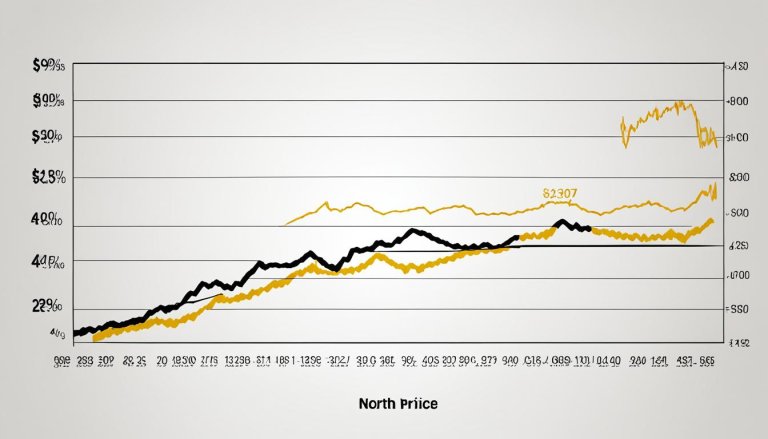If you’re interested in buying or selling gold, understanding the weight conversion between troy ounces and grams is crucial. Gold is typically measured in troy ounces, with one troy ounce equivalent to 31.1034768 grams. This standardized measurement ensures accuracy when determining the weight and value of gold.
Unlike the standard ounce, which is commonly used for everyday weight measurements, the troy ounce is specific to the precious metals industry. It’s important to recognize this distinction, as using the incorrect unit of measurement can significantly affect calculations and pricing.
Whether you’re a seasoned investor or new to the world of gold, knowing the weight conversion from troy ounces to grams is essential. Stay informed and make accurate decisions when it comes to gold in grams by understanding the conversion and its significance in the market.
Why Does Oz Vs Ozt Matter?
The use of troy ounces (ozt) in the gold industry is significant because it ensures accuracy and consistency in weight measurements. When calculating gold bullion prices, using an avoirdupois ounce (oz) instead of a troy ounce (ozt) can result in a discrepancy of approximately 10%. This difference in weight directly impacts the value of the gold product. It is crucial for investors to understand the use of troy ounces in the industry to ensure accurate pricing and comparisons.
Gold weights are commonly measured in troy ounces (ozt) due to historical and industry standards. Unlike the avoirdupois ounce (oz), which is commonly used in everyday measurement, the troy ounce is specifically used for weighing precious metals.
- Troy Ounce (ozt): A unit of weight measurement primarily used in the precious metals industry.
- Avoirdupois Ounce (oz): The standard unit of weight measurement for general purposes, not specific to precious metals.
The weight discrepancy between the two systems arises from the different measurement standards. One troy ounce is equivalent to 31.1034768 grams, while one standard ounce is equal to 28.35 grams. This means that a troy ounce is approximately 10% heavier than a standard ounce.
The use of troy ounces is crucial when determining the value of gold products. For example, when purchasing gold bullion, knowing the weight in troy ounces allows for accurate pricing and comparisons across different products. Using the incorrect measurement can lead to significant discrepancies in the perceived value, potentially resulting in financial losses for investors.
By understanding the difference between oz and ozt, investors can make informed decisions based on accurate measurements and ensure they are getting the full value of their investment.
History Of Troy Ounces For Precious Metals
The use of troy ounces for weighing precious metals has a long-standing history dating back to the Middle Ages. The system is believed to have originated in the French city of Troyes, which served as an important trade market for gold and silver.
The adoption of the troy ounce as the standardized measurement took place in England during the 15th century. Subsequently, the United States also embraced the use of troy ounces with the Coinage Act of 1828.
This system of measuring precious metals with troy ounces ensures consistency and standardization in the industry. By using a standardized measurement, the gold trade can accurately assess the weight and value of precious metals, providing reliability to buyers and sellers alike.

This Image Depicts The Historical Significance Of Troy Ounces
How Many Grams In An Ounce Of Gold?
When it comes to gold measurements, understanding the conversion from troy ounces to grams is crucial. One troy ounce of .999 fine gold weighs precisely 31.1034768 grams. This is the most common measurement used for gold, alongside grams.
It is important to note that while a troy ounce weighs exactly 31.1034768 grams, many gold bullion coins and bars may contain a slight amount of additional gold. These additional grams can vary, often by an extra 100th or two of a gram.
When comparing gold prices and sizes, having a clear understanding of the exact weight of gold in grams is essential, especially when comparing products measured in grams versus troy ounces.
To illustrate the weight conversion visually:
As seen in the image, one troy ounce of gold is equivalent to 31.1034768 grams.
By knowing the precise weight of gold in grams, investors and collectors can make accurate comparisons and ensure they are getting the value they desire in their gold products.
The Difference Between Troy Ounces And Standard Ounces
When it comes to weighing precious metals, understanding the difference between troy ounces and standard ounces is essential. While both measurements are used in various industries, they differ in terms of weight and value.
One troy ounce is equivalent to 31.1034768 grams, whereas one standard ounce is equal to 28.35 grams. This means that a troy ounce weighs approximately 10% more than a standard ounce. The variance in weight can significantly impact the calculations and pricing involved in dealing with precious metals.
Using the appropriate weight measurement is crucial to ensure accurate calculations and pricing when buying or selling gold, silver, or other precious metals. Miscalculations due to using the wrong measurement can result in significant discrepancies in both weight and value.
Let’s take a closer look at why the distinction between troy ounces and standard ounces matters in the precious metals industry. Understanding the difference will enable you to make informed decisions when it comes to buying, selling, or valuing your precious metals.
The Significance Of Troy Ounces In The Precious Metals Market
Troy ounces play a crucial role as the standard unit of measurement in the precious metals market. Whether you are a seasoned investor or someone starting to explore the world of precious metals, understanding the significance of troy ounces is essential.
When it comes to pricing precious metals like gold, platinum, and silver, they are often listed per troy ounce. This consistent pricing method allows for easy comparison across different products and marketplaces. It provides a standardized unit of measurement that ensures transparency and fairness in the industry.

Additionally, the use of troy ounces helps maintain purity standards. Precious metals are meticulously tested and graded based on their composition. By using troy ounces, it becomes easier to calculate and verify the precise amount of precious metal in a particular product. This ensures that buyers and sellers are accurately assessing the value and quality of their investments.
Whether you are buying physical bullion or trading in the futures market, understanding troy ounces is critical for making informed decisions. By knowing the weight measurement, you can assess the true value of your investments and analyze market trends with accuracy.
Benefits Of Using Troy Ounces:
- Consistent and comparable pricing
- Standardized measurement for transparent transactions
- Maintains purity standards
- Accurate assessment of value and quality
In conclusion, troy ounces are the foundation of the precious metals market. They provide a reliable and standardized unit of measurement that ensures fair pricing, transparency, and accuracy in the industry. Whether you’re a seasoned investor or just starting, understanding troy ounces is vital for navigating the world of precious metals.
The Legacy And Importance Of Troy Ounces
The troy ounce has a rich history and holds significant importance in the precious metals industry. Believed to have originated in Troyes, France, it quickly spread throughout Europe and Britain, becoming a widely recognized measurement for precious metals. This standardized unit of measure has played a vital role in facilitating accurate pricing and trading within the industry.
With its historical significance dating back to the Middle Ages, the use of troy ounces for weighing precious metals has stood the test of time. It became the standard measurement in England during the 15th century and was later adopted by the United States. The troy ounce offers consistency and standardization, allowing for fair and reliable transactions of precious metals.
Today, the legacy of troy ounces continues to shape the precious metals market. It ensures that purity standards are met and provides investors with a universally recognized unit of measurement for gold, silver, platinum, and other precious metals. The adherence to troy ounces allows for accurate pricing, making it easier to compare and evaluate the value of different precious metal products.
Furthermore, the historical significance of troy ounces serves as a reminder of the longstanding tradition and value of precious metals. The use of this measurement system adds a layer of authenticity and confidence to the industry, as it has been relied upon for centuries by traders, investors, and collectors alike.
In conclusion, the troy ounce is an integral part of the precious metals market, carrying a legacy that spans centuries. Its historical significance, combined with its standardized use in pricing and trading, establishes it as a trusted and essential measurement for precious metals, ensuring accuracy and consistency in transactions.
Conclusion
Understanding the conversion from troy ounces to grams is vital when it comes to accurate measurements and calculations in the gold industry. A troy ounce of gold weighs exactly 31.1034768 grams, ensuring precise and reliable weight determination. By comprehending the distinction between troy ounces and standard ounces, individuals can effectively price and compare different gold products. The use of troy ounces as the industry-standard unit of measurement guarantees consistency and accuracy in the precious metals market.
Accurate measurements are paramount in the world of gold trading and investment. Whether you’re buying or selling gold, knowing the exact weight in troy ounces and converting it to grams enables you to make informed decisions. This knowledge helps you determine the true value of your gold and ensures fair transactions.
When it comes to gold, accuracy is key. The use of troy ounces and understanding grams conversion allows for precise calculations and standardized measurements. Whether you’re a seasoned investor or a beginner in the gold market, being familiar with the accurate measurements of troy ounce gold in grams is essential for making sound financial decisions. By mastering these concepts, you can navigate the gold industry with confidence and ensure accurate valuations of your precious metal assets.


